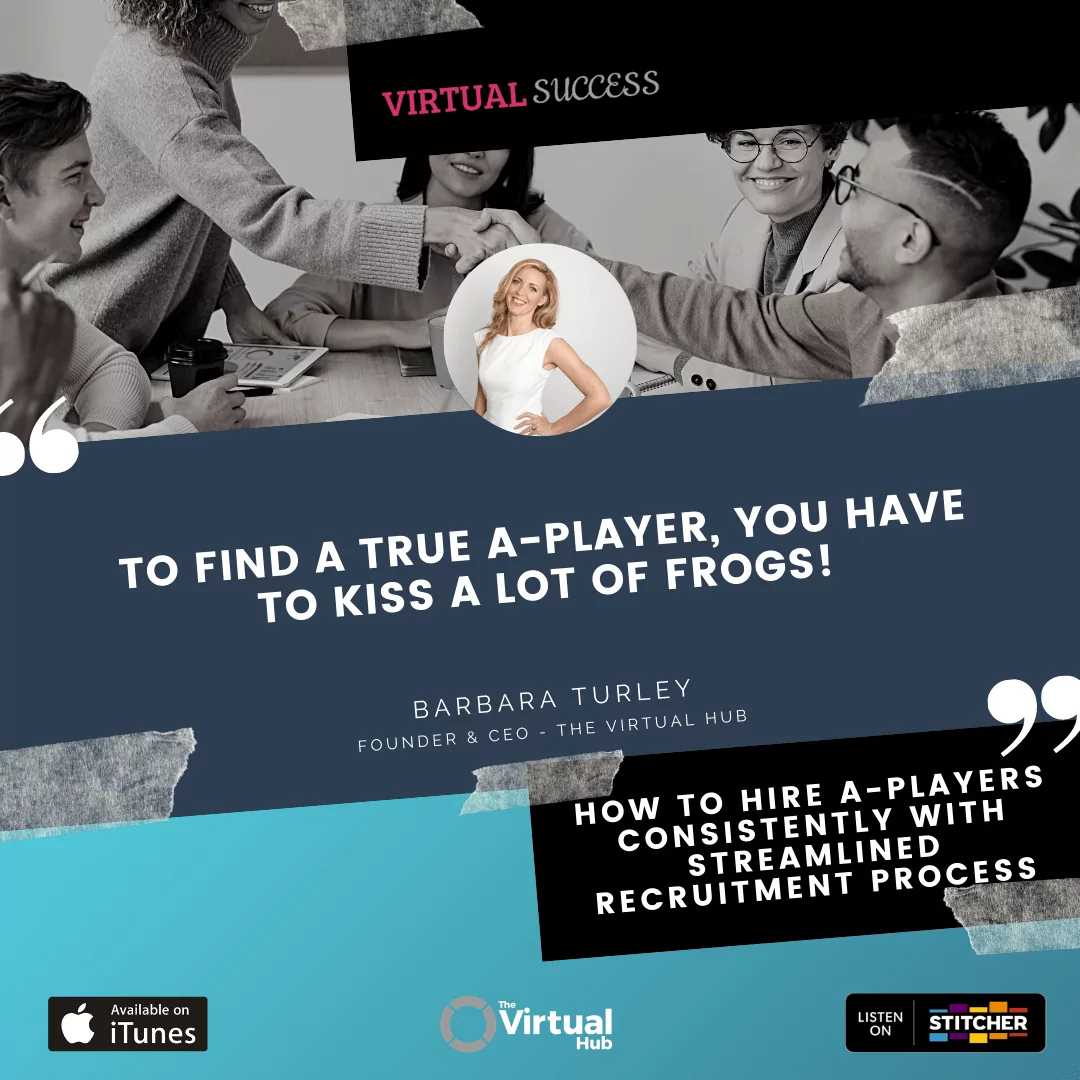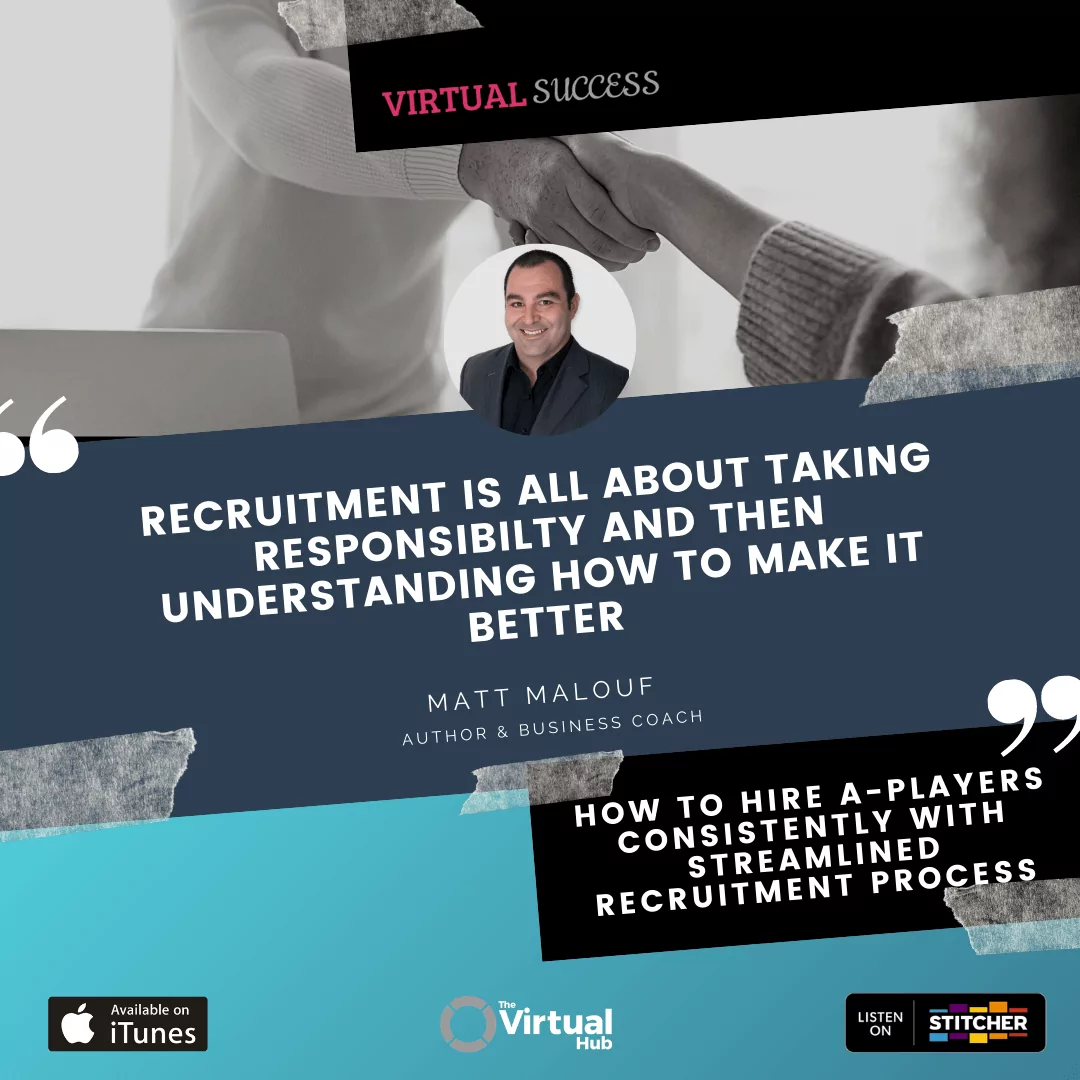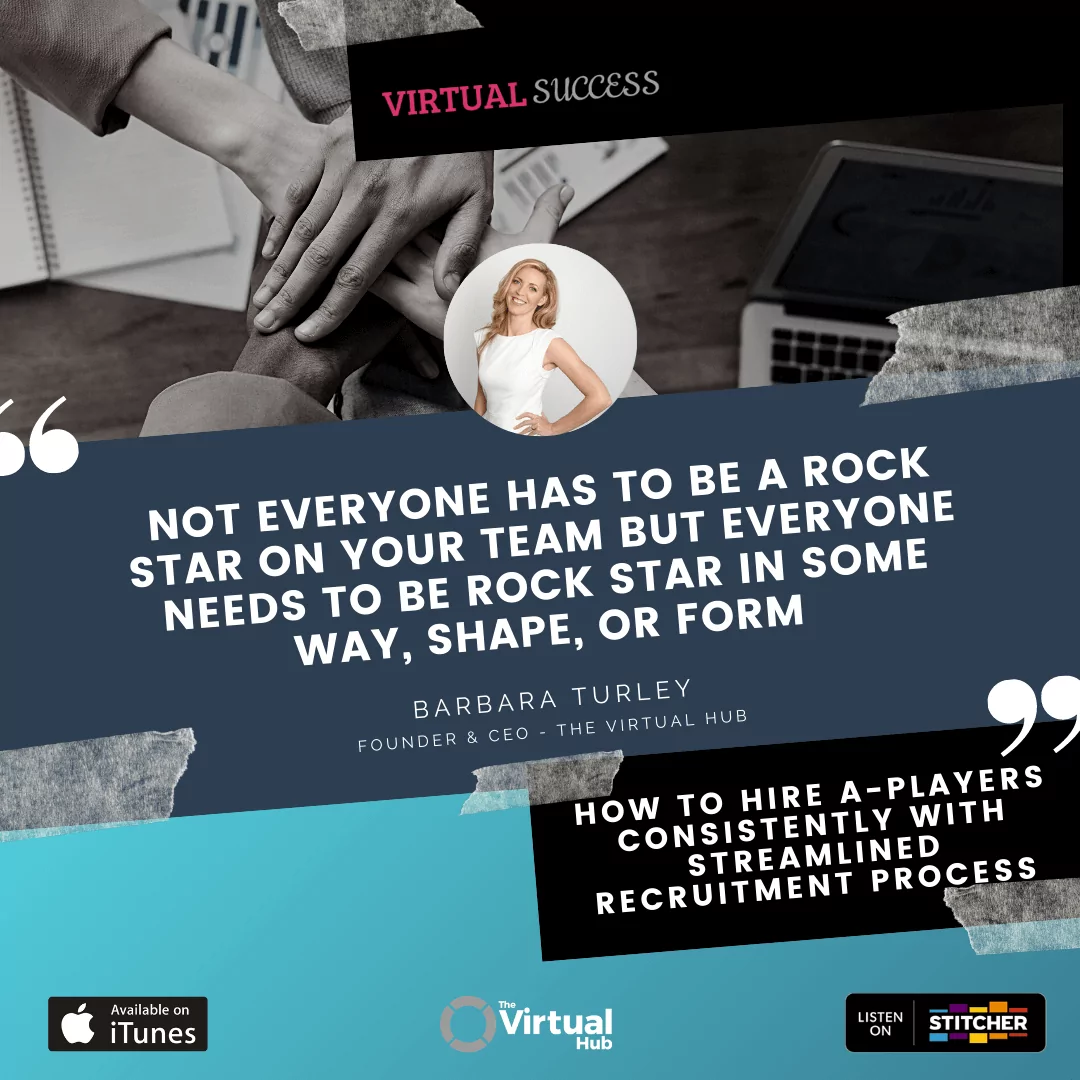How to Hire A-Players Consistently with a Streamlined Recruitment Process
Want the transcript? Download it here.
In this episode, Barbara Turley and her co-host Matt Malouf discuss The Virtual Hub’s recruitment process, what makes it different from others, and the secret to hiring A-players in your business.
Some key points include:
- The importance of having a great recruitment process
- Three key things to remember when recruiting
- How to determine A-players from B and C-players
Let us know what your key takeout has been from this episode and join the continuing conversation over in the Virtual Success Facebook Group.
In this episode:
2:39 The Virtual Hub’s Recruitment Process
8:40 Recruitment Status in this Crisis
11:05 How to avoid bringing in the wrong people
14:20 Attitude vs Skill
17:48 Three key fundamentals in Recruiting
21:59 Wrapping things up
Intro: Do you find yourself running out of time to accomplish your work, are you spending time doing things that you’re not that good at? There are effective ways to outsource these tasks so you can focus on your business. This is the Virtual Success Show, we bring the inside scoop on outsourcing success for entrepreneurs by entrepreneurs. And now, here are your hosts Matt Malouf and Barbara Turley.
Matt Malouf: Hi, everyone and welcome to another episode of the Virtual Success Show where I’m joined by my co host, Barbara Turley. Hi, Barbara. How are you today?
Barbara Turley: I’m great Matt and you?
Matt Malouf: Yep, going really, really well… really well. Very excited to starting to see what we’re coming out of lockdown through this pandemic that we’ve been going through and life is starting to get back to some form of normality. How is it on the; I’m in Australia today and your in France. How’s it, how’s things over in your neck of the woods?
Barbara Turley: Well, you know, I’m just excited too Matt because the restaurants are opening this week. So, you know, we’re slowly opening up, but we can finally have a glass of wine somewhere else other than our house. So that’s got to be a good thing. So but yeah, very slowly opening up, everyone wearing masks where we are. But I guess that’s the right thing to do for now. But good to see us all opening up again.
Matt Malouf: And today’s show, I wanted to actually spend some time interviewing Barbara, because we’ve been having a few conversations recently off air. And one of the most interesting things that we’ve been talking about is the recruitment process. And the hiring of VAs and how Barbara and her team are doing that process at the moment. But the, I guess, not just about the process, around, I guess the numbers behind how many VAs are the like you’ve got to go through or interview to get to a diamond and I wanted to share that with everybody today because I think it’s an area of business that so many business owners struggle with, which is hiring a little and hiring their VA. So I wanted to spend some time just getting Barbara’s insights and sharing that with you all today. So Barbara, I guess let’s start with regards to hiring VA’s and the like. What is the sort of process? Is it just a, do you just follow a traditional recruitment process? Or are you doing something a little bit different to test and find the right people?
The Virtual Hub’s Recruitment Process
Barbara Turley: Yeah, great question, Matt. Because, you know, a lot of people would have different definitions of what is the traditional recruitment process, I suppose in most people’s head, that is put out a job ad, get a load of applications, look at a few resumes, narrow them down, interview a few people and pick the one you like the most. Over the years, you know, you start off doing that. But really and I know we did a full show on this, you and I before where I dissected out our recruitment process, and it is a lengthy process that we go through that involves a lot of metrics.
And it is very, we only bring in the relationship piece at the very, very end of the process. So what I mean by that is, we don’t even interview people until they’ve jumped through about 10 different hoops, and we’ve tested them in certain areas. And only at that point, are we sort of saying we’re interested in meeting with them and having a chat. And interestingly, 50% of people still fail at that stage, even though like the majority have already fallen at the other hurdles that we’ve set along the way. And still, in that interview stage, 50% of people will fail right there. So it’s very difficult.
Matt Malouf: I mean, for many business owners, just even the thought of 10 steps before he gets to an interview. They’d be probably sitting there going, I don’t have the time for that. Why such a lengthy process, Barb?
Barbara Turley: Well, in my experience, if you want to get you know, everyone says they want to hire A-players. But in order to find a true A-player, it’s like you have to kiss a lot of frogs, right? Because you don’t know, the people applying for jobs, depending on the type of the level of role that you’re looking at. But you know, when we’re recruiting for VAs, for example, it’s not a lower level job, but I mean, it’s not a leadership position. It’s not at, the pool is large. So when you’re, when depends what rank you’re going for in a company. But when you’re looking for a kind of a rank and file sort of position, where the masses might come and apply, and especially if you’re saying that you offer training, like for example, the way we do, you’re going to get people who are switching industry and that sort of thing happening.
So in our experience to try to find the A-players, they don’t often walk through the door with the correct color coat on, if you know what I mean. So you have to kind of, you can often find diamonds in the rough. And you have to be able to look past certain things so that you might find the diamonds that you’re looking for. I hope that makes sense. It’s kind of a difficult thing. And really, metrics is the way to filter it fast, is to filter a lot of people down to the people you actually want to speak to.
Matt Malouf: Yeah, it’s so interesting. Like, you wouldn’t think something like recruitment would come back to metrics, but the numbers don’t lie in any area of business. And I think that’s the key. And once you, the only way to get a set of metrics, like what you’re talking about, is through spending a lot of time and having a large data set to be able to produce that.
Barbara Turley: Well, if you think about it, Matt as well, I was just thinking there, you know, the majority of people, the majority of businesses, spend little or no time or you know, scant time on recruiting. They might pay an agency, they might spend but really is it a folk? Is it a department within the business, usually not unless you’re a very large company. But if you think about it, the people that you’re bringing in and allowing to walk through the door of your business, if you put as little energy into your, you know, account your finance area, or your delivery of product or sales or your marketing area, as most businesses do in the recruitment area, your entire business would fail.
So, in The Virtual Hub, recruitment is like one of the linchpin departments where we say to ourselves, every time we see a problem within the company, even if it’s like, after two years of having the same employee, we actually look back and go, Hmm, we look back at all their recruitment, testing and all of the notes that we took through the entire process, and we try to figure out whether we should have seen that or whether we can recruit that out in future. That’s how much energy we put into it.
Matt Malouf: That’s brilliant. The number of people that will not do that, they’ll actually point the finger at the person versus taking responsibility and going back, right at the beginning of the process and going, how could we have changed things back here? Is there anything that we need to improve or change right at the beginning? Oh, that’s amazing, you know? I mean, that’s a really important point for everyone to take home. It’s taking the responsibility, and then understanding how we can make it better. That’s brilliant Barb.
Barbara Turley: Well, you know, when you’re talking about setting expectations Matt, we did a show on setting expectations with your team. And you know, when somebody doesn’t meet expectations, or somebody doesn’t, you know, perform on the job or whatever and you think you just have, how could they have been so confused? If that thought goes through your head for a moment, think about how they could have been so confused, potentially. It happened way back in the ad that you put out for the job. Potentially, not always.
But if you go right back to the source, you’ll think well, how did this person first walk through our door? It was the ad and how was that written? What were they told in the entire process that they came through? And then on the onboarding and the training and the coaching and the quarterly catch-ups and all this stuff going forward, either they were just a C-player that you hired, you thought they were an A-player, and or it was your process that caught the whole thing out, maybe, just worth asking those questions.
Matt Malouf: And so in the current climate, Barb, what are you, as you’re recruiting for VA, are you seeing anything different at the moment?
Recruitment Status in this Crisis
Barbara Turley: Yes, yes and no. Okay, so yes, in that we are seeing large numbers of people applying for jobs, which you know, is always great because once the pool gets bigger, then you can start to see great people are being released from other companies like so. For example, companies like Airbnb, who have a history of training their staff pretty well, and having a good culture and that sort of thing. You know, they’ve had to let some people go so that, you know, they happen to be in the same city as us in Cebu. And although we’re not in the same industry as the travel industry or Airbnb, we would be keen to see some of their potential stars that might actually be coming out of those places because we can retrain them, they’re still great, A-players are always A-players, right?
So that’s been very interesting. But the thing that hasn’t changed is the metrics, I still can’t believe we were talking about this off air. We’re still, I’m still seeing the same number of people, the same percentage of people pass, fail, succeed, wow us, that percentage just has not changed, which is fascinating to me. It feels like that it doesn’t matter what happens, there still only 2% to 5% or, you know, maybe 5% to 10% of people are exceptional regardless of the skill set or regardless of industry,
Matt Malouf: And that’s one of the things I love about the standard that you set in this industry, Barb is that, you know, here the pool is bigger, you’re getting more applications and you’ve had probably in a long time, yet you don’t drop the standard and the stats don’t lie. So it’s the law of averages right working here. And I think what’s really, really important is that last statement that you made that are in sort of between 2% and 10% cut it.
And my thought is, the only reason you can say that with confidence is because of the number of people and the experience you’ve had over the years. And so many business owners would react in a hiring scenario, and bring the A-players on in the hope that they get to make them As. Have you had experience in that before, where you’ve seen, you’ve probably gone against your metrics or your process, and then you brought on the wrong person.
How to avoid bringing in the wrong people
Barbara Turley: So many things I want to unpack in that. I just want to make sure I get the whole picture for you. So yes, 100% I have. So number one, we ran a test last year about a year ago. So just it wasn’t in a crisis situation or anything where we’ve done this twice where we dropped our metrics and we decided not dropped it, but we lowered the standard. And we decided are we, have we set the bar so high that literally nobody can get through it. So we lowered it and what we noticed was that the difference was night and day between if we lowered it. And it just, the quality of an ability of people coming through was just, was way lower. We weren’t finding amazing people that accidentally just didn’t do well in the particular tests that we had. So that was number one.
And number two, the other thing I wanted to say about recruiting, usually the reason people end up hiring B and C-players is because they are in a panic. They don’t hire strategically thinking forward, they hire when they need somebody. And that means that you go out and you got to get it done pretty fairly quickly. Recruiting and sort of employment branding is something that you need to have as part of, well, some companies are very small, so they don’t really need to have it all the time. But you need to be constantly scouting, and constantly looking for talent because sometimes talent comes along at the wrong time. And it doesn’t mean that you create space for them in your company. Not everyone can do that. But sometimes it might be worth and trying to create space for the right A-player when they come along and not just when you’re desperate for that position.
And then dealing with B-players, so let’s say you do hire somebody that it depends what type of B-player they are, and I’ve experienced with this as well. So if they are a B-player where you have somebody that’s a great person, that is smart, has enthusiasm in their DNA right now that’s important because you cannot train for enthusiasm. They’re enthusiastic about what it is that they’re doing. And they have a sense of grit about them. So they are, have the ability to rise to a challenge. If you have somebody like that, that comes in, but let’s say they can’t do, they can’t, they haven’t got the skills yet. That’s a B-player that is coachable. You can coach and train that person because skills are teachable.
The other things I mentioned or not, you’ve got to hire for them. So if you find, if someone is a B-player, because they’re not performing on the job because of training, but they have all the other elements, that is someone that you can coach up into an A-player, in my opinion, if you have a B-player, because of things like low energy, lack of interest, generally kind of you know, fixed mindset instead of growth mindset, it doesn’t matter about their skills they’re not, they’re probably a C-player really that just did okay. Does that make sense? It’s because there’s a lot to unpack there in everything I’ve said.
Matt Malouf: And I think just to summarize, it’s attitude trumps skills every time.
Barbara Turley: Every time, like every time.
Attitude vs Skill
Matt Malouf: And you said something that I think I want everyone to really hear, you said it earlier, which is an A-player is always an A-player, irrespective of what they’re doing. And that comes back to the attitude piece that we’re talking about here. And you just, you can’t train enthusiasm. You can’t fake enthusiasm, either. Like at the end of the day, someone will come in and yes, they might pull the wool over your eyes once but inevitably, it’s got to be part of their being. Otherwise very quickly, they’re going to be exposed and if you’ve got a thorough process that you’re taking people through, inevitably, you’ll identify that.
Barbara Turley: Yeah, so I would encourage people to just think about the things in your business that you can train for. Now, training is a whole other thing, maybe you don’t have time for training and you need to hire someone that has the skills. But if you’re trying to hire somebody that is already, has all the skills and all the things I talked about, they’re probably going to be quite expensive.
So you’ve got to think about it’s a balancing act between where is your company at or your business and what can your business kind of afford right now and which side are you, I would always say I would go with the culture fit and the enthusiasm and all that first and then work on the training because you can really grow that person up into your business. You don’t always have to get all the things in the first hire or in the beginning and pay up for it.
Matt Malouf: And you know what’s been really interesting through this pandemic, Barb, what I’ve been seeing in the coaching I’ve been doing with clients, this attitude piece during tough times is amplified. So if you’ve got somebody that is exceptional when it comes to attitude, enthusiasm, their attitude, is amplified through this time and if you’ve got someone that’s on the wrong side of that line, it’s amplified through this time as well.
And it’s been really interesting watching the companies that are crushing it at the moment. It’s largely due to, they’ve got the right people with the right attitudes, who are just gunning for the business and wanting to see the business succeed. And the ones that are failing and not only because of lockdowns or shut downs or anything like that, they’re actually crumbling because as a unit, they’re not unified. They’re not sharing the common traits and goals and attitudes that are what winning requires.
Barbara Turley: You can see it even in, you know, you would see it in clients you coach, you can read about it in newspapers, but all the businesses that, in general, forget about being in a crisis. The businesses that win in general, are usually led by leadership teams or leaders that will always look at themselves first and they tend to have a growth mindset. Well not tend to, you kind of have two growth mindsets, positive, generally positive attitude, and generally and then through a sort of a glass is half full approach, an ability to see opportunity when others can’t, and that is why people like that win. But it’s not everyone has that trait, so it’s difficult. You don’t have to have I mean, not everyone has to be a rock star on your team. But everyone needs to be a rock star in some way, shape, or form. So depending on the role, in my view
Three key fundamentals in Recruiting
Matt Malouf: So if we were to leave the listeners with three key fundamentals around this piece, Barb, what would your top three tips be?
Barbara Turley: Yep. So tip number one is very simply that people matter, right? So people matter in any business. And because of that, the energy that you put into things like recruitment, employment branding, employment opportunity for people will pay you dividends in the end. It’s something that you just need to think about. That’s on the front on the way in. The other thing that, you know, with people matter is thinking about the journey that somebody is taking with your company that matters to them. So, people matter, it’s important to have a people focus within any business. And it is time consuming, it’s a bit tiring, but it’s actually, people matter. So that’s the first thing I would say.
The second thing I would say is when, if you do have A-players or B-players that are coachable, open to A-players, those people tend to like working with other A-player’s or coachable B-players. And I’ve made this mistake in the past, if you are seen to be supporting C-players or the bludgers, right? It actually demotivates your A-players if they see you doing that. So if you’re favoring somebody or you’re allowing bad behavior to go on in your business, it actually demotivates and turns off those who are A-players and B-players. And I’ve learned that lesson the hard way, a couple of times. So take it from the horse’s mouth.
And my third point would be, people like generally to work in streamlined machines of businesses, because that makes it more fun. And Matt, you and I talk about this all the time, building a machine, making sure that everyone’s clear on their role, clear on what they’re, you know, accountable for. There’s a nice process running you know, people get to be creative, where they want to be creative and show initiative etc. But generally speaking, you want to have a well-oiled machine running that people want to be part of. I think those would be my three key things.
Matt Malouf: I’m going to add one little bit to your point too, because it’s such an important point. When you’ve got the A and B-players, they will help you select or deselect others within the team as well. And you’ve got to listen to them. So if you’re A or B-players are coming to you with feedback around other team players, that’s legitimate, so not we’re not talking about whinging and whining in that kind of rubbish. But legitimate feedback, constructive feedback.
You must listen to them in line with Barb’s point because these people are critical to the success or failure of your business. And, inevitably, if you don’t maintain the standard around the A’s and the B’s, you’ve got the right attitude that you can build into As, they will leave and you’ll be left with C-players, which you cannot build a great business on the back of.
Barbara Turley: I know you’d be putting out fires all day and driving yourself mad. And actually, if I could finish on a tip around that, you know, allow people through your recruiting and your general process, create ways for them to deselect themselves. And the best way for you to do that is to be extremely transparent about what they’re entering and almost make it not difficult, but you know, make them jump through some hoops because those that want to work for your company will jump through those hoops and they’re the ones you want to have. Because they’re inspired by what you’re doing. And they’re actually, it’s like inbound marketing kind of thing there. They are magnetically attracted to what it is that you guys do, and the others allow them to deselect themselves before you ever hire them. That’s what we tend to do at The Virtual Hub. We’ve had people drop out and we go well, it’s better they dropped out now, before we hire them, they give up in the process.
Wrapping things up
Matt Malouf: Barbara that has been amazing. I’ve got a page full of notes that I’ve feel like this has been for me this show. I’ve got so many great notes. I hope the listeners have taken a lot from this. If you’ve enjoyed the show, please we’d love your comments around the show, we’d love for you to give us a review. But more importantly is to share this with your community because our goal is to help as many business owners and entrepreneurs success with their virtual teams as possible because we believe it is paramount and critical to business success these days. But yeah, Barbara once again, love your input. Love your, what you’ve given to the community today. And thank you and we’ll join for another show soon.
Barbara Turley: Thanks very much, everyone.
Outro: Thank you for listening to the Virtual Success Show. If you found this show helpful. Take a moment to share it with a friend so that we can all grow together.
The Hosts
Matt Malouf
Matt Malouf is a passionate business coach, speaker, author and entrepreneur on a mission to help entrepreneurs around the world break the shackles of mediocrity and reach new levels of personal and business success.
Barbara Turley
Barbara Turley is the Founder & CEO of The Virtual Hub, a company that specializes in recruiting, training, and managing superstar ‘Virtual Assistants’ in the social media, digital marketing, and systems automation space.






